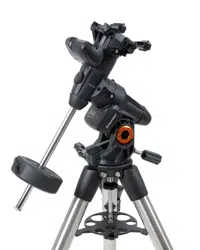Loading ...
Loading ...
Loading ...

ENGLISH I 27
Aligning the Finderscope
The finderscope is adjusted using two adjustment screws,
located on the top and on the right (when looking though the
finder) of the finder bracket and a spring-loaded pivot screw
(located on the left side of the bracket). This allows you to
turn the top adjustment screw to move the finderscope up
and down, and turn the right adjustment screw to move
the finderscope right to left. The spring-loaded pivot screw
puts constant pressure on the finder so that the adjustment
screws are always making contact with the finder.
To make the alignment process a little easier, you should
perform this task in the daytime when it is easier to locate
objects in the telescope without the finder.
To align the finder:
1. Choose a conspicuous object that is in excess of one
mile away. This will eliminate any possible parallax effect
between the telescope and the finder.
2. Point your telescope at the object you selected and
center it in the main optics of the telescope.
3. Lock the azimuth and altitude clamps to hold the
telescope in place.
4. Check the finder to see where the object is located
in the field of view.
5. Adjust the thumb screws on the finder bracket until
the cross hairs are centered on the target.
Removing the Lens Cap
The EdgeHD and Schmidt-Cassegrain telescopes utilize a
lens cap with a bayonet-type locking mechanism to hold it
in place. To remove the lens cap, hold the cover firmly and
rotate the outer edge 1/2” counterclockwise and pull off.
Polar Aligning the Mount
Latitude Scales
The easiest way to polar align a telescope is with a latitude
scale. Unlike other methods that require you to find the
celestial pole by identifying certain stars near it, this method
works off of a known constant to determine how high the
polar axis should be pointed. The Advanced VX mount can
be adjusted from 7 to 77 degrees.
The constant, mentioned above, is a relationship between
your latitude and the angular distance the celestial pole
is above the northern (or southern) horizon; the angular
distance from the northern horizon to the north celestial pole
is always equal to your latitude. To illustrate this, imagine that
you are standing on the North Pole, latitude +90°. The north
celestial pole, which has a declination of +90°, would be
directly overhead (i.e., 90° above the horizon). Now, let’s say
that you move one degree south — your latitude is now +89°
and the celestial pole is no longer directly overhead. It has
moved one degree closer toward the northern horizon.
This means the pole is now 89° above the northern horizon.
If you move one degree further south, the same thing happens
again. You would have to travel 70 miles north or south to
change your latitude by one degree. As you can see from
this example, the distance from the northern horizon to the
celestial pole is always equal to your latitude.
If you are observing from Los Angeles, which has latitude
of 34°, then the celestial pole is 34° above the northern
horizon. All a latitude scale does then is to point the polar
axis of the telescope at the right elevation above the northern
(or southern) horizon.
To align your telescope:
1. Make sure the polar axis of the mount is pointing due
north. Use a landmark that you know faces north.
2. Level the tripod.
3. Adjust the mount in altitude until the latitude indicator
points to your latitude. Moving the mount affects the
angle the polar axis is pointing. For specific information
on adjusting the equatorial mount, please see the section
“Adjusting the Mount.”
Loading ...
Loading ...
Loading ...
